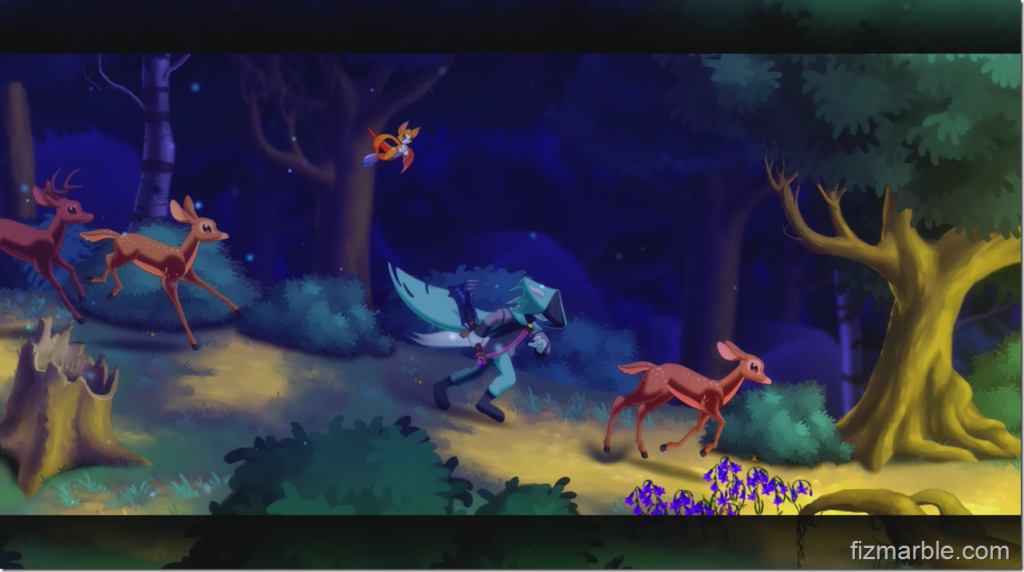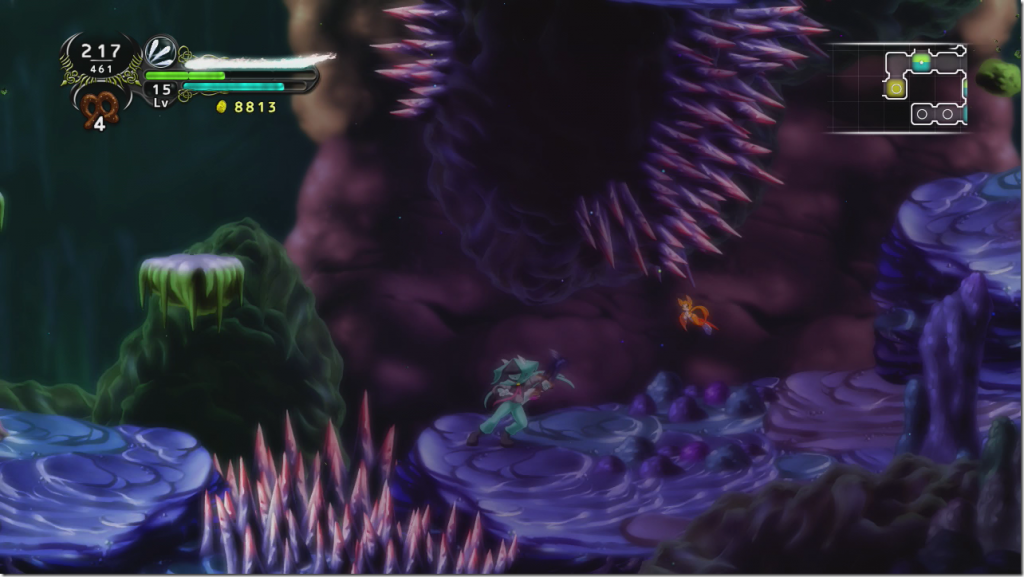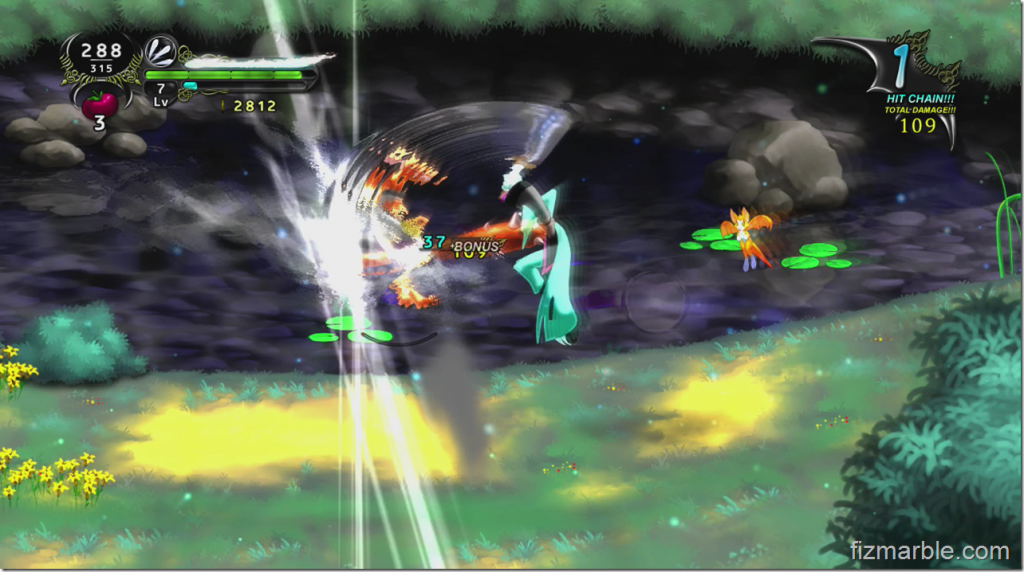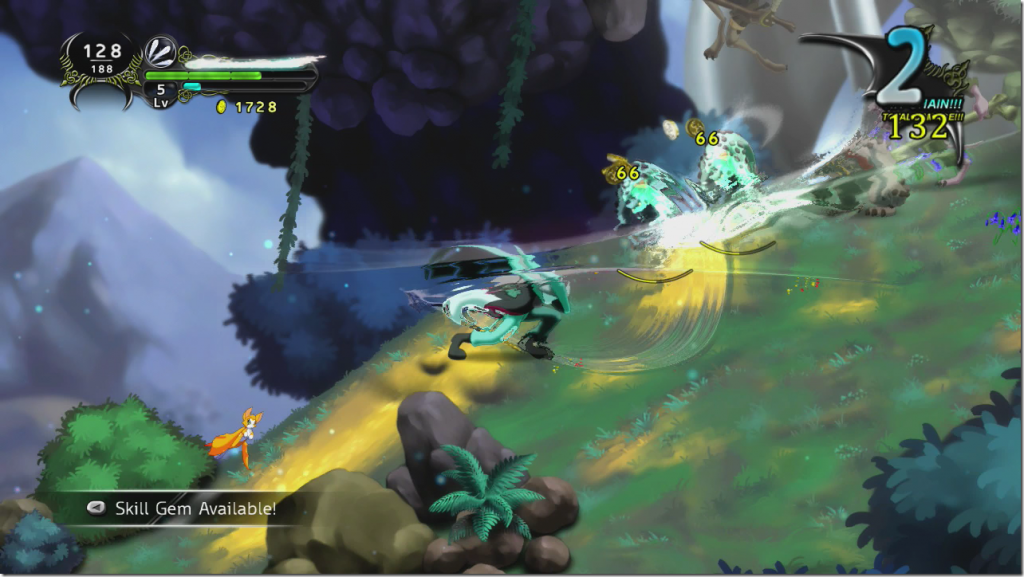I don’t want to wait until the end of the review to tell you I think this game is amazing and that you should buy it. I feel like it almost does an injustice to the efforts of it’s creators to pick it apart and tell you what I think of it’s elements. But I was selected to inform you, based on my opinion, if this game is worth your time and money. It is, and because it’s my job, I will tell you why.
Dust: An Elysian Tail has an interesting conception story, which you should read, but I am not going to tell you about it here. The purpose of this review is not to pull up the interesting history surrounding the making of the game. We are going to look at the present, where D:AET exists in it’s completed, wonderful form.
Story
An Elysian Tail begins with Dust raised from the dead with no memory of who he was before his demise. The events that follow teach the player and Dust himself more about his past, and more importantly, his present.
The story is told primarily through dialog popups with close ups of the characters and are animated nicely. The mood and attitude of the speaker is always displayed through the animation and coincides with the voice acting well.
Even though the look of the game is child friendly, the story deals with mature themes such as love, loss, guilt and redemption. These won’t scare away the kids, but the way the story elegantly unfolds will go over their heads.
Occasionally you are given a choice on how Dust will respond to an action or dialog. This helps to make Dust’s Journey a little more your own.
I loved how self aware the game is. Fidget, a side kick of sorts, often breaks the fourth wall with comments like “I hope you saved recently.” as you approach a dangerous area, and “Wait, did you just put that in your inventory?” as you collect a farmer’s lost sheep. This comic relief is well balanced with the intense sword fights and the heavy themes that reoccur along the story arc.
Graphics
You can usually, in a few moments, determine a lot about a game from the way it looks. High res 3D models say “big budget, AAA” while cartoony ‘Saturday morning’ graphics usually say “low budget” or “kid’s game”. And usually we are correct in our assumptions. But occasionally, we are deceived, and sometimes we don’t give a game a chance because it has a certain look.
D:AET may deceive you based on it’s looks. And while the graphics generally maintain a G-rated look despite tearing up countless monsters with your sword, they belie the darker, more mature themes in the story.
This game looks nice, cute even, in pictures. I mean look at those deer! It could pass for a reboot of Bambi. In motion, the game becomes something even more beautiful. Each character (and there are many) has their own look. Many of the characters are anthropomorphized animals, including the main character Dust. I saw clothing styles that borrowed from China and European trends.
The art design is fantastic, showing off a great variety of moods (light hearted, dark and gloomy, haunted). The different regions that you will visit on your adventure are varied in their setting. Likewise, the monsters vary from region to region so you never feel like you are fighting the same baddies.
The visual effects in D:AET are rich in detail and seem like organic, natural occurrences, rather than the product of some game designer. Fire effects and explosions, lighting, your sword whooooshing through the air, wind, water, mist, everything looks good and it all fits neatly into the art style. Once you start, nothing jars you from the experience. Everything looks like it belongs.
Sound
The sound compliments the music incredibly well. Many games employ an industrial, mechanical element to their menu sounds, but D:AET takes place in an enchanted land with mystical properties and characters, and the sounds are perfect for helping you understand that.
Everything visual has a clear matched audible cue. The menu sounds are pleasant and the sword sounds are excellent whether they are the slashing of monsters or the clashing against shielded opponents.
The music sets the tone well enough and is neither memorable nor distracting. It’s almost not noticeable, which I believe to be a sign of a score well written. Mood music works best when you don’t know it’s there.
Every bit of dialog in the game is voice acted and for the most part it’s very well done and fits the art style like a glove. During the conversations, it’s almost like watching an 80’s cartoon like He-Man, with playful dialog and a dramatic flair to all of the characters to give each their own distinct personality. If all of this bothers you, there are always easy options to skip the dialog.
Gameplay
Dust: An Elysian Tail is a side-scrolling platformer/action/RPG. Though it may not look like it or even feel like it, you actually control three characters at the same time. Dust is the rabbitish dude you see wearing the conical Asian hat. The Blade of Ahrah (that’s your sword. It is sentient. Somehow this is ok.) is the second. And Fidget, a nimbat, is the third. Fidget also serves as a context guide to let you know when you can enter a building, or talk to a villager. She will also let you know when there is treasure near.
Movement (running, ducking) is governed by the left thumb stick. A to jump, X and Y to strike with your sword in various combinations, B to unleash Fidget’s rather pathetic special move. Her move is so weak that the game points out how weak it is (more on this later) and teaches how to amplify it by holding the Y button and creating a whirlwind with your sword, directing the attack at your whim. You can also press and hold the X button just before an attack to parry and daze your attacker. The left and right triggers are used to dodge *gasp* left and right. It was a little strange at first having directional dodge buttons (usually there would be a single dodge button and your dodge direction would be based on the direction of the thumb stick) but I got used to it before long and now it is completely natural.
The controls are very responsive and combat starts fairly easy and works it’s way up to high intensity battles. The game does a great job of honing your skills and gradually preparing you for the encounters to come, and there are rewards for those at a higher skill level, including challenge rooms with leaderboards.
With every kill and side quest comes experience points. These add up to give you gems that allow you to increase your base stats, so you can build a character suited to your play style.
There are numerous unlocks for weapons and armor and they serve to boost your attack or defense or luck, pretty standard fare. These are merely stat boosts and there is no visual indication of what gear you have equipped, but it’s a cool addition for those who like to be the most effective monster slayers they can be.
There are also special characters that, when unlocked, give permanent stat bonuses. And since Dust has an Indie heritage, it pays homage to some other Indie heroes with these special characters.
The Tail End
With all that D:AET has to offer, it makes me wonder how this game can sell for 15 dollars, while Rayman Origins started at retail at 60 bucks. They are both great games, but the amount packed into D:AET will make you feel like a filthy thief for paying so little and getting so much.
While there is no multiplayer component to D:AET, it isn’t a mode that feels missing. This is an experience you don’t need to share with anyone else.
We saw some great games in the last several weeks for the Summer of Arcade promotion. I am confident that the decision makers at Microsoft put Dust: An Elysian Tail as the headliner for a reason. It stands out, not just as a great Summer of Arcade game, but as a brilliant add to the Xbox Live Arcade lineup.
Five out of Five






